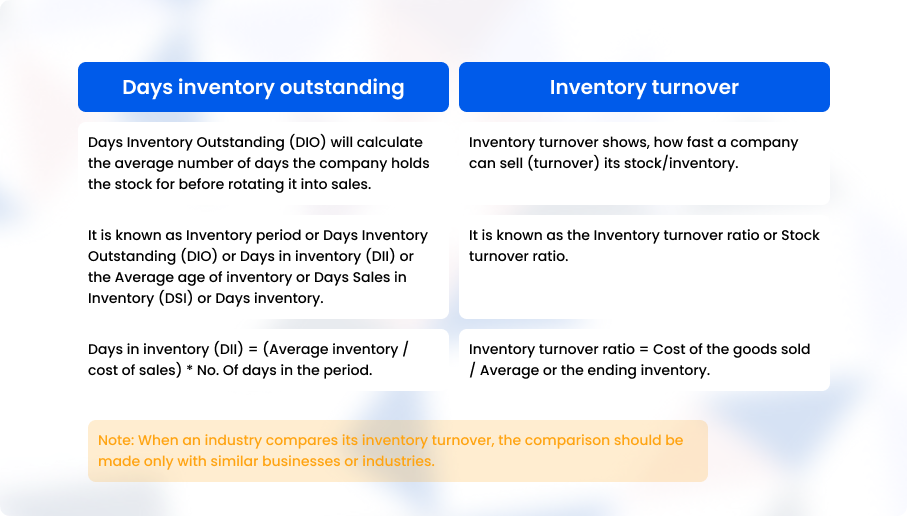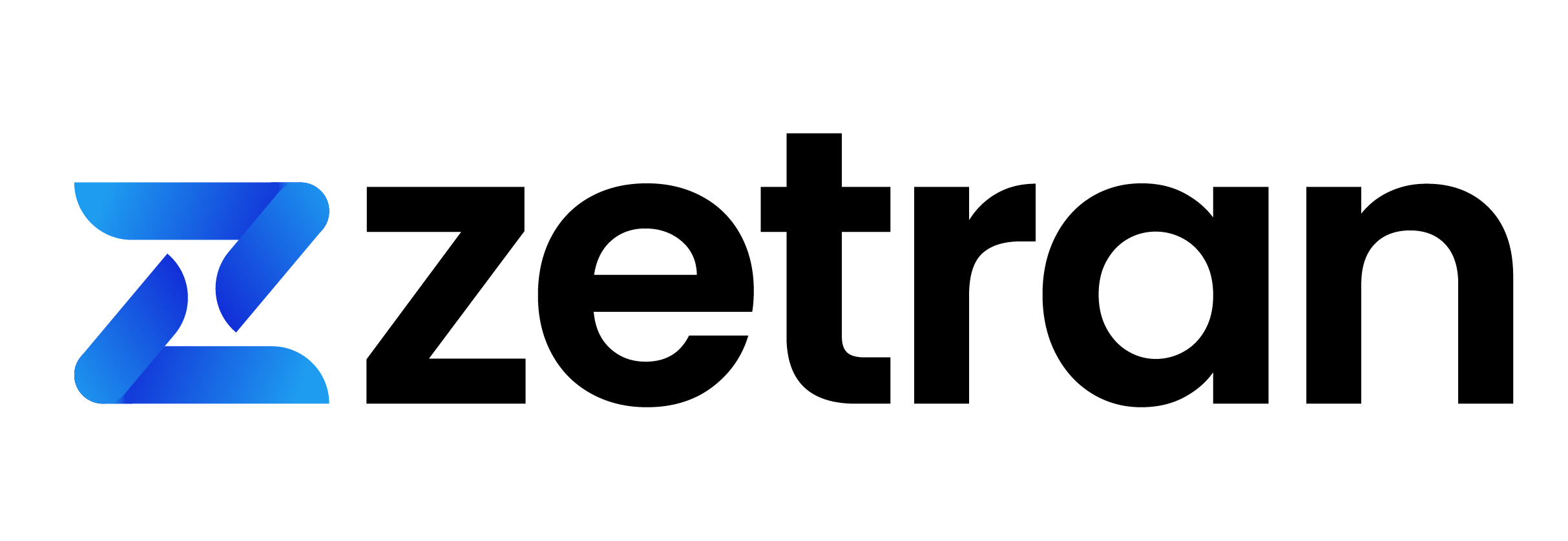In this article, we are going to discuss,
Days in Inventory (DII)
- Definition
- Formula
- Calculation
- Example
- How to interpret days in inventory?
- Importance
- Difference between DII Vs Inventory turnover
Inventory Turnover
What is the days in inventory (DII)?
Days in inventory, are also named as days inventory outstanding (DIO), inventory days of supply, and the inventory period. Simply put, these are the days your inventory stays in your hand. Inventory period/ Days Inventory outstanding / days in inventory is an efficiency measuring ratio of the total average number of days, the organization, or the company that holds all their inventory before selling it.
In simple words, days in inventory are the total number of days the respective company takes to turn inventory into sales. These average days in inventory (DII) may vary from their type of industry.
How to calculate days inventory outstanding?
Using the valuable days in inventory (DII) / days inventory outstanding / inventory period data, you can understand your inventory management, how efficiently you run your business, and can identify the area of improvement in your industry.
What is the formula to calculate days in inventory (DII)?
To calculate the inventory turnover ratio in days, use the below formula,
Days in inventory (DII) = (Average inventory / cost of sales) * No. Of days in period.
Here,
The formula to calculate Average inventory is
Average inventory = (Beginning Inventory + Ending Inventory) / 2
- The cost of sales is nothing but the cost of goods sold.
- And, No. of days in a period = Any required time frame, that is weekly/ quarterly/ yearly
Example for calculating days inventory outstanding (DIO)
Let us take a company called “X” who sell television on four types of brands. The seller would like to calculate the particular brand moving with the better sales in terms of inventory management. The seller gives you a task to calculate the days in inventory (DII) with all four brands.
Brand 1:
Average annual inventory = $1500
Cost of sales = $15,000
No.of days in period = 365
DIO =?
Thus,
Days inventory outstanding (DIO) = ($1500 / $15,000) * 365 = 36.5 days
Brand 2:
Average annual inventory = $ 2000
Cost of sales = $35,000
No.of days in period = 365
DIO =?
Thus,
Days in inventory (DII) = ($2000 / $35,000) * 365 = 20.9 days
Brand 3:
Average annual inventory = $2500
Cost of sales = $ 45,000
No.of days in period = 365
DIO =?
Thus,
Days inventory outstanding (DIO) = ($2500 / $45,000) * 365 = 20.3 days
Brand 4:
Average annual inventory = $1000
Cost of sales = $25,000
No.of days in period = 365
DIO =?
Thus,
DIO) = ($1000 / $25,000) * 365 = 14.6 days
Thus, Days in inventory (DII) for,
Brand 1 = 36.5 days
Brand 2 = 20.9 days
Brand 3 = 20.3 days
Brand 4 = 14.6 days
From the above-calculated DII, you can easily justify which brand is performing well. With the help of this calculation, the seller can use the marketing strategy to make, the less-selling brand reach potential customers and increase sales to grow the business. Even the seller can drop the brand if it performs poorly.
Note:
You also have another formula to calculate the Days Inventory Outstanding (DIO)
The formula is,
Days Inventory outstanding = 365 / Inventory turnover
How to interpret days in inventory (DII)?
With the help of days in inventory, you can analyze how your business inventory is efficient! Also, the inventory days may vary, most of the time based on the industry and their products. Here for the interpretation of days in inventory (DII), you have two cases.
- Low days in inventory
- High days in inventory
Low days inventory outstanding
If an industry faces low days inventory outstanding then, the respective company is efficiently turning their inventory into sales. Thus the low inventory days represent whether the business is efficient in its inventory management and performance of sales.
High days inventory outstanding
If an industry faces high days inventory outstanding then, the performance of the respective industry from turning their inventory to sales is not efficient. Thus, this state is a bad sign of sales. This indicates that you have more inventory with less amount of sales. This will affect your business cash flow.
How the inventory management software helps your business?
Inventory Management Software is a web-based application that holds all your business’s inventory data in one place for quick and easy access from any computer with an Internet connection. It’s simple to use and easy to arrange, allowing you to drag and drop products into the appropriate status categories. In addition, the interface allows you to set date restrictions on each part of the process, so your team knows when items are being purchased or going out of stock.
Importance of days in inventory (DII)?
- Days in inventory (DII) provide a benchmark for measuring the optimization of inventory management.
- DIO measures how quickly a company converts inventory into cash. You can easily understand your industry’s performance with the help of high DIO or low Low.
- You can improve your industry by comparing with the help of the present state of your industry.
Difference between the days inventory outstanding Vs. inventory turnover?

Inventory turnover shows, how fast a company can sell (turnover) its stock/inventory. Whereas, Days Inventory Outstanding (DIO) will calculate the average number of days the company holds the stock for before rotating it into sales.
Inventory turnover metric provides investors with an indication of how well a company is managing its inventory. The higher the turnover number, the quicker the turnover of the product. Fast turnover shows strong consumer demand for a company’s product.
Day inventory outstanding Vs Inventory turnover – The special consideration
When an industry tries to compare its inventory turnover, keep in mind the comparison should be made of both similar businesses or industries. For instance, if you start your baking business and if you pursuing that business, make sure to compare with similar industries. Not with other business fields such as a retail store or other.
The second consideration is manipulating inventory turnover with discounts or closeouts. This can be considered as the major drain on return on investment (ROI) and profitability.
How to calculate inventory turnover?
As we discussed above, the inventory turnover provides you the information regarding the inventory sold for a particular time period. To calculate your inventory turnover, the cost of sold goods must be divided by the average or ending inventory for the particular period.
What is the inventory turnover formula?
The formula to calculate inventory turnover ratio is,
Inventory turnover ratio = Cost of the goods sold / Average or the ending inventory.
Here,
The reason behind using the average inventory is that industries might have either a higher level of inventory or a lower level of inventory for a certain period of the year.
And as we discussed above,
Average inventory = (Beginning Inventory + Ending Inventory) / 2
Also, you have to note that we use the same parameters to measure both the days in inventory and the inventory turnover.
Example to calculate the inventory turnover ratio?
Assume the company called “X”. For the fiscal year 2021, the company “X” prepares a report containing the annual sales of $500 million, holding
Beginning inventory = $ 39 million,
Ending inventory = $ 40 million,
And, the annual cost of goods sold = $ 350 million.
The company X’s inventory turnover for the year is,
$350 million / ( ($39 million + $40 million) / 2 ) = 5.93 million
The company X’s days inventory is,
(1/5.93) x 365 = 61 days.
Thus the above example of inventory turnover for company X says that the industry sells the complete inventory within 61 days.
What is an ideal or a good inventory turnover ratio?
An ideal or good inventory turnover ratio is ranging between 5 and 10 for most organizations. This indicates that an organization should sell and restock its inventory every one to two months.
If your industry contains easily spoiling products and goods, then their ideal ratio will be considerably higher. This will prevent the industry inventory spoilage losses.
Related Article
Inventory Shrinkage | Definition, Formula, Cause and Prevention
Inventory shrinkage is one of the common issues. Inventory shrinkage will result in your business in profit drop. Read more
Beginning and Ending Inventory Calculation [with Example]
The beginning inventory is the book value of all company inventory by an organization or a business at the starting accounting period. Read more
Inventory Write Off | All you Need to Know with Example
Inventory write-off is just a term used in the accounting process of decreasing the inventory value that has totally lost all of its value. Read more
Exploring Retail Store Management System & Inventory Management
The store remains to be an essential part of material management. It is because they keep the materials that are to be accounted for and maintained safely. Read more





